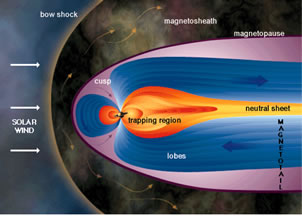This is a drawing of the magnetosphere of Saturn.
Click on image for full size
A Look at Saturn's Magnetosphere
Saturn's magnetosphere is not as big as Jupiter's, but it is still pretty big.
It is big enough to hold all of Saturn's moons. The shape of the magnetosphere is affected by its size. The shape is also affected by the fact that Saturn's moon Titan does not contribute a very large cloud to the magnetosphere.
The rings of Saturn definitely affect the motion of particles in the magnetosphere.
Saturn's magnetosphere produces beautiful aurora, as well as strong radio signals and other waves, such as whistler waves.
You might also be interested in:
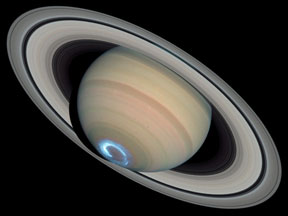
Have you ever seen the Southern or Northern Lights? Did you know that other planets (besides Earth) have them too? Scientists call these cosmic light shows the "aurora". Saturn is one of the planets that
...more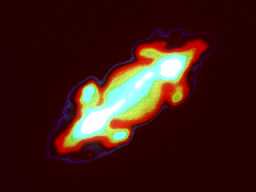
La plasmasfera de Saturno es bastante grande. La mayoría del plasma proviene de una nube con forma de rosca (toroide) de material de Titán y otras lunas heladas. Aparte de iones y electrones, la plasmasfera
...more
Saturn's plasmasphere is pretty big. Most of the plasma comes from the donut-shaped cloud of material from Titan and the other icy moons. Besides ions and electrons, the plasmasphere also contains very
...more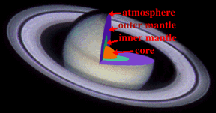
The Giant planets do not have the same kind of layers inside that the earth-like planets do. The history of the giant planets was so different that they formed with much more gas on the inside. Saturn
...more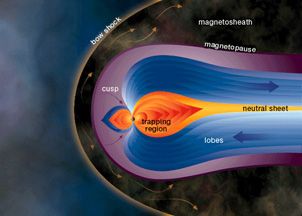
A magnetometer is an instrument for measuring magnetic fields. Many spacecraft carry magnetometers to measure the magnetic fields around planets. When a spacecraft makes those measurements, what do the
...more
There's a lot of strange stuff going on at both the North and South Poles of Saturn. Two of Saturn's moons also have interesting polar regions. Let's take a look! The atmosphere and clouds are quite odd
...more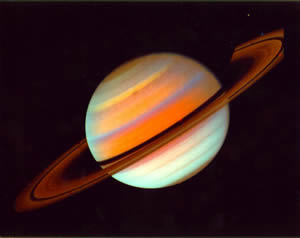
Saturn is the second largest planet in our solar system. It is also very bright in the sky. The ancient Greeks named the planet after the god of farming and time. The rings of Saturn were first seen by
...more


